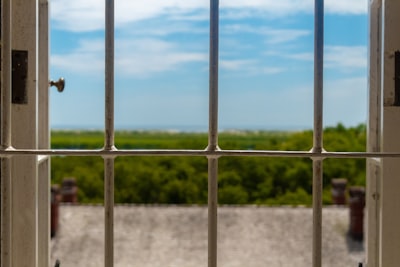The St. Augustine Lighthouse is illuminated by the moon’s shimmering light. This amplifies the air’s eerie stillness and the sense of mystery surrounding it. The lighthouse is on Anastasia Island in Florida and serves as a beacon for both ships at sea and people interested in ghost stories. The St. Augustine Lighthouse is a haunted place renowned far beyond the state of Florida. Not only for its architectural grandeur but also for the scary tales of paranormal activity it harbors. It is known for its rich history and its spirit visitors.
The History of the Haunted Lighthouse
The St. Augustine Lighthouse is not only an enticing location for ghostly encounters, but it is also a tribute to exceptional engineering and historical value. This ancient lighthouse, which stands 165 feet tall, was built in the late nineteenth century. The spiral staircase that weaves its way up to the top is its distinguishing feature, giving both practical access and an element of architectural majesty.
The lighthouse was built on the grounds of a British shipwreck, which now serves as a breathtaking spectacle for visitors. The enthralling story of the lighthouse’s construction unfolds as one ascends the spiral staircase, providing a window into the past while simultaneously providing a stunning and panoramic perspective of the surrounding environment.
Over the years, it was maintained by several keepers, including the Andreu and Rasmussen families, both of whom experienced tragedies associated with the lighthouse.

Eliza and Mary Pittee, the superintendent of the lighthouse project, drowned while the tower was being built, causing Hezekiah Pittee to suffer a personal tragedy. The girls tragically perished while playing in a supply cart that tragically fell into the water.
Another event included Joseph Andreu, a lighthouse keeper, who died after falling to the ground while painting the tower. Maria, his devastated wife, assumed his responsibilities and became Florida’s first recognized female lighthouse keeper.
These sad incidents have provided fodder for many ghost legends. Unsettling incidents have been recorded by guests and personnel, including youngsters laughing for no apparent reason, a ghostly woman climbing the lighthouse stairs, and a shadowy man strolling the pathways around the tower’s top. Some people think that they are the lingering ghosts of the Andreus and the Pittee sisters, who are shackled to the lighthouse they once called home.
Haunting Legends and Supernatural Phenomena
Strange occurrences and paranormal activity have been recorded by visitors, including shadowy figures climbing the lighthouse steps, spectral children’s laughter, and the phantom aroma of cigar smoke, thought to have come from Keeper Peter Rasmussen, a notorious cigar smoker.

Late in the 19th and early in the 20th century, Rasmussen worked as a keeper. He was reputed to have had a deep fondness for the nautical beacon and was well renowned for his scrupulous maintenance of the lighthouse.
Local legend has it that Rasmussen adored cigars and frequently smoked them while on duty. Even after his employment ended, some guests and workers have mentioned smelling cigar smoke around the lighthouse, raising the possibility that Rasmussen’s ghost may still be present there.
Paranormal investigators like those from the popular show “Ghost Hunters” have documented unexplained phenomena, including strange orbs and chilling, disembodied voices. A recurring theme seems to be the spirit manifestations of the girls who drowned during the lighthouse construction. Many claim to have heard their ethereal laughter echoing in the night.
Popular Culture and Media Coverage
St. Augustine Lighthouse has captured public imagination through numerous media portrayals, most notably in episodes of paranormal investigation shows such as “Ghost Hunters” and “Ghost Adventures”.
The media coverage has not only amplified its haunted reputation but also sparked increased interest and visitation. Several documentaries and news reports featuring chilling accounts and purported evidence of poltergeist phenomena have continued to add layers to its spooky reputation.
Investigation and Research Efforts
Multiple paranormal investigations have taken place at the lighthouse, notably by well-known organizations such as TAPS from “Ghost Hunters.” Recordings of spectral voices, video of shadowy figures, and readings of strange energy swings are among the evidence offered. Despite the abundance of proof, doubters continue to doubt the veracity of the allegations. Many people ascribe their experiences to chance, imagination, or the power of suggestion.
Visitor Experiences and Urban Legends
Visitors often share personal accounts of chilling encounters, from feeling an inexplicable chill to hearing spectral whispers or laughter. The urban legends surrounding the lighthouse mainly revolve around the spirits of the Pity girls and the tragic keepers. These stories not only fuel the tourism industry but also form an integral part of the local community’s identity and history.
Preservation and Tourism

The lighthouse is preserved by the St. Augustine Lighthouse & Maritime Museum, reflecting its historical and cultural importance. Dark of the Moon ghost tours offer visitors a chance to experience the haunting firsthand, and special events like the Lighthouse Night Fest attract paranormal enthusiasts. The combination of history and haunting has been an economic boon for the area, boosting local businesses and attracting a steady stream of tourists year-round.
Conclusion
St. Augustine Lighthouse’s continuing notoriety is a monument to both its historical significance and its spectral residents. Its distinct features make it a magnet for both history buffs and paranormal aficionados. The obsession with haunted houses, such as this lighthouse, testifies to our natural curiosity about the unknown, as well as the draw of a good, spine-chilling story. As long as the moon shines on the towering silhouette of St. Augustine Lighthouse and the sea whispers tales of bygone days, the mystery surrounding its ghostly occupants will entice the courageous and curious, keeping its spectral legends alive for future generations.
Frequently Asked Questions (FAQs) about St. Augustine Lighthouse
Q1: Where is St. Augustine Lighthouse located?
St. Augustine Lighthouse is located on Anastasia Island, within the city of St. Augustine, Florida.
Q2: Is St. Augustine Lighthouse open for public visits?
Yes, the lighthouse is open to the public. It’s preserved by the St. Augustine Lighthouse & Maritime Museum, and offers guided tours.
Q3: Can I experience the hauntings at St. Augustine Lighthouse?
Yes, you can. The lighthouse offers the Dark of the Moon ghost tours, which are specially designed for visitors to experience the haunted tales associated with the lighthouse.
Q4: What is the most recurring paranormal activity at St. Augustine Lighthouse?
The most frequently reported paranormal activities include hearing ghostly laughter believed to be from the Pity girls who drowned during the lighthouse construction, shadowy apparitions moving up the lighthouse steps, and a phantom scent of cigar smoke.
Q5: Is the lighthouse still operational?
Yes, St. Augustine Lighthouse is still an active lighthouse and it is maintained by the St. Augustine Lighthouse & Maritime Museum.
Q6: Has St. Augustine Lighthouse appeared on television?
Yes, the lighthouse has appeared in several television shows and documentaries that deal with paranormal activities, such as “Ghost Hunters” and “Ghost Adventures.”
Q7: What are the major tragedies associated with St. Augustine Lighthouse?
There are two main tragedies associated with the lighthouse. These include the drowning of the superintendent’s daughters during its construction and the death of Keeper Joseph Andreu, who fell from the tower while painting it.
Q8: Are there any skeptics about the hauntings at St. Augustine Lighthouse?
Yes, despite numerous reports of paranormal activity and ghostly encounters, some skeptics question the authenticity of these experiences. They attribute them to natural causes, imagination, or the power of suggestion.






